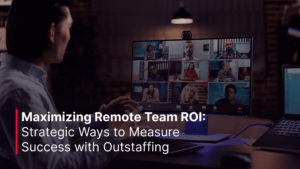Remote teams and outstaffing make financial sense, and the numbers are already on the table: anywhere from 15-40 % in cost savings compared to hiring in mature markets, depending on the role and geography. But as any board member will tell you, cutting costs is not the same as creating value. Remote Team ROI is a compound metric. It means looking at business critical process and the way remote teams create value.
It’s both the challenge and the opportunity to measure ROI in ways that reflect outstaffing’s strategic impact, so today we’ll take a look at that. The real return lies not in labor arbitrage, but in how this model accelerates growth, mitigates volatility, expands options, and creates real innovation.
Speed: Why Velocity Has Become the Hardest Currency
In industries where competitive windows are shrinking, time is no longer an operational detail but determinant of enterprise value.
Outstaffing directly attacks the slowest part of the business machine: talent acquisition. In the US, the average time-to-hire for a software engineer hovers around 61 days. For specialized roles in AI or cybersecurity, it often stretches past three months. In fast-growth sectors, those months are lethal. By contrast, strong outstaffing partners can spin up fully functional teams in 3-4 weeks, slashing lead time by more than half.
The ROI here goes farther than faster payroll onboarding, with earlier revenue recognition, shorter R&D cycles, and the ability to hit the market while the opportunity is still hot. The difference between being first or second to market can mean a permanent loss of 10–20% of share in industries with network effects. That erosion doesn’t show up in HR dashboards, but it should be at the center of any ROI conversation.
Risk: ROI in the Things That Don’t Happen
Underestimating the silent cost of risk until it materializes with a failed hire can cost up to 30% of an employee’s first-year salary in replacement, training, and lost productivity. Compliance errors in cross-border hiring can result in six-figure fines or barred market access. And the reputational impact of repeated layoffs is harder still to quantify, but very real.
Outstaffing, done right, shifts a portion of these risks onto the partner. Recruiting, retention, payroll, and compliance burdens sit with the outstaffing firm, not the client. This doesn’t mean risk disappears, but it becomes distributed and, crucially, reversible.
Think of ROI here as an insurance layer.
Optionality: The Underpriced Value of Strategic Flexibility
Economists talk about “option value”: the financial worth of having the right, but not the obligation, to act. Outstaffing, in many ways, is an organizational option strategy.
The model allows companies to launch pilot projects, test new markets, or build secondary product lines without committing to permanent overhead.
This kind of ROI that rarely appears in quarterly reports but defines long-term competitiveness. The ability to place multiple small bets, and absorb the cost of failure cheaply, is how innovation pipelines are sustained. Internal-only models, constrained by fixed payroll, simply cannot match that level of experimentation.
Innovation: Remote Team ROI Measured in Defensibility Over Delivery
There’s another, often invisible dividend from outstaffing: the infusion of external expertise. Remote engineers embedded across industries accumulate a portfolio of experiences and practices that in-house teams often lack. When integrated properly, they bring with them not just execution capacity but pattern recognition.
Innovation ROI is notoriously hard to measure, but it is tangible in its outputs: differentiated products, accelerated adoption, and customer stickiness.
Data Grounding the Argument
The numbers behind this narrative:
- Outsourcing is a global phenomenon:
- 92% of Global 2000 companies use IT outsourcing;
- 29% of US businesses with <50 and 66% of >50 employees outsource work.
- The strategic shift moved to creating value through outstaffing business partnerships:
- Companies report 15–30% cost savings through outsourcing overall (ITMAGINATION, MyOutDesk);
- Business Process Outsourcing (BPO) market growth: the BPO sector alone is expected to grow from $302.62 billion in 2024 to $328.37 billion in 2025, with a forecasted CAGR of 9.8% from 2025 to 2030.
A New Kind of Remote Team ROI
On top of the obvious immediate financial savings, the new standard of outstaffing should be at the intersection of Western-quality talent and lower prices.
In our activity at Bytex, we’ve found that this type of collaboration means to our customers that they work with a partner who’s experienced, qualified to understand the bigger picture, aware of all potential vulnerabilities both technical and product-wise.
If you’d like to learn more about our processes, drop us a line.


